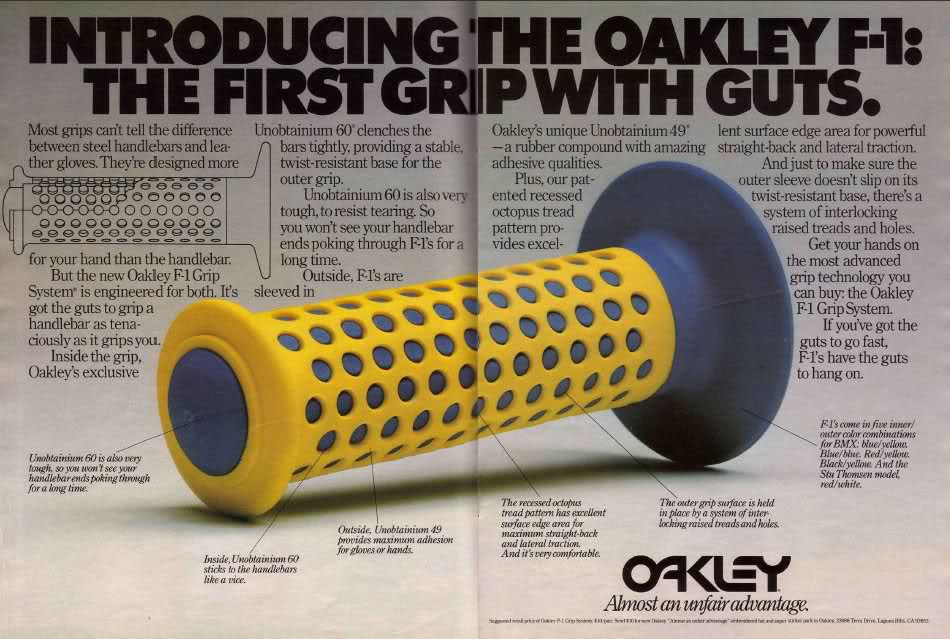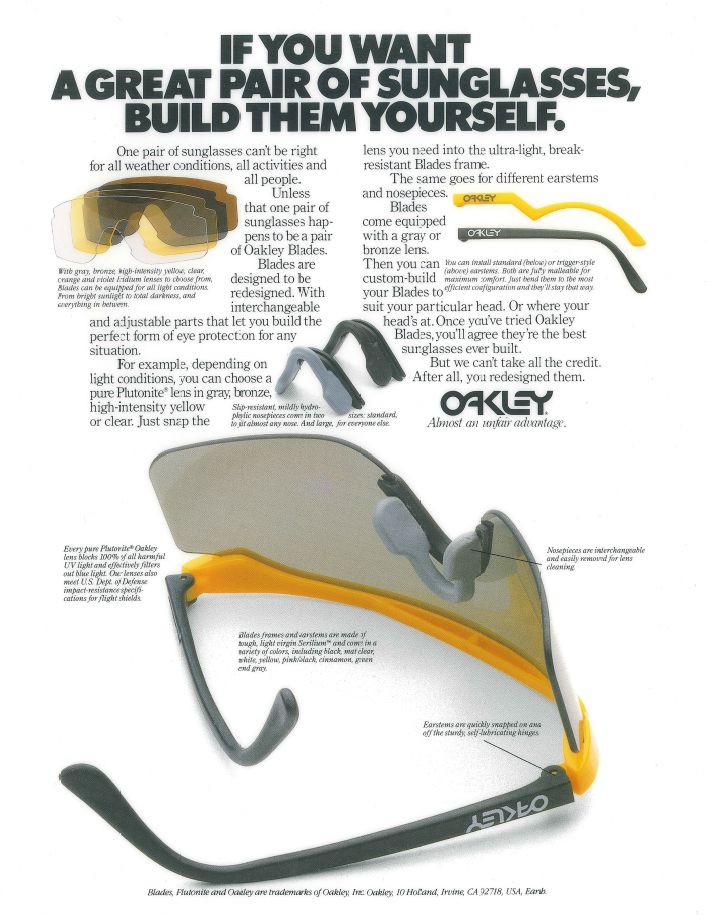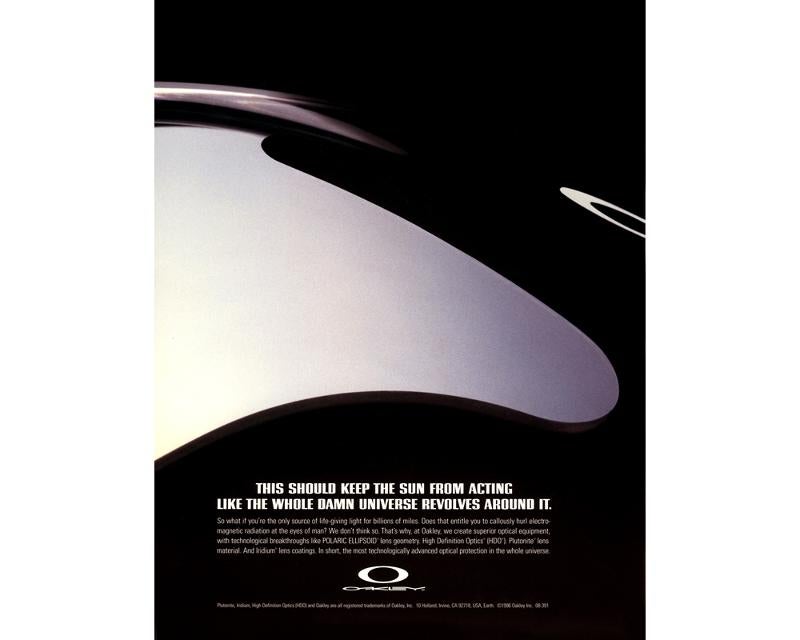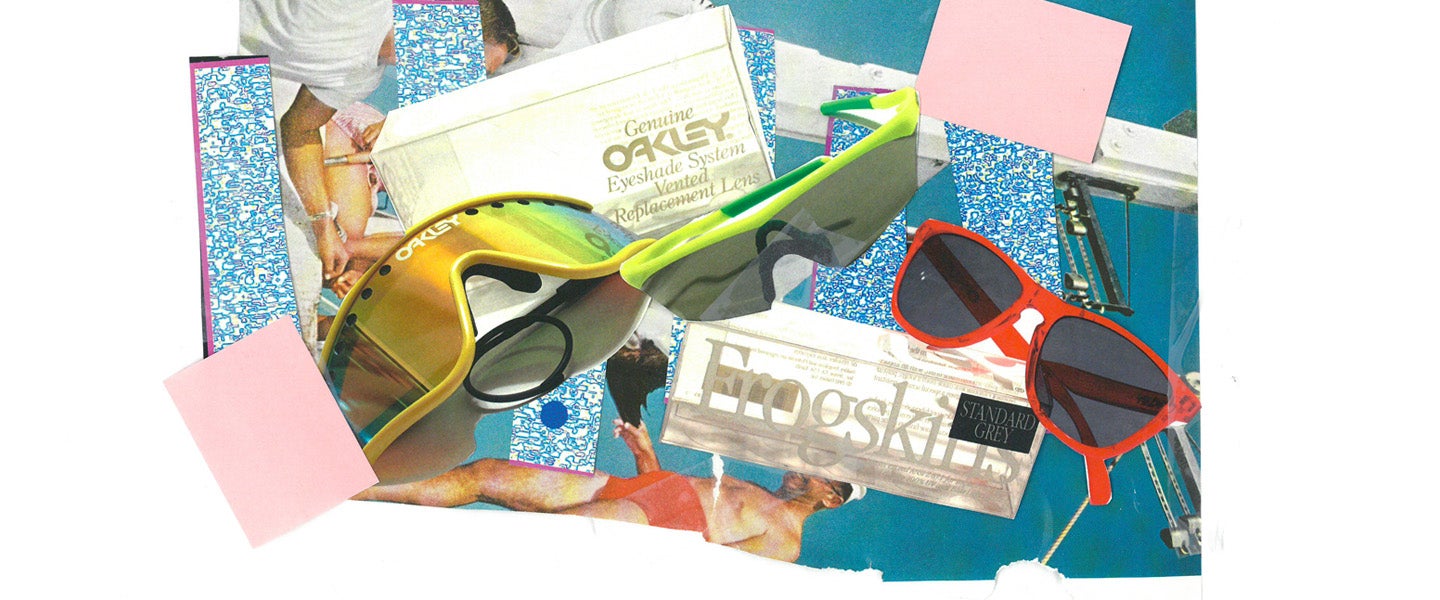If you were a human being alive in the world during the 1990s and early 2000s, you either owned a pair of Oakley sunglasses, or you knew someone who owned at least three. They were, for a time, the personification of ‘90s XTREME cool no matter what age you were or where you lived — it didn’t matter whether you were hyped up on Mountain Dew or just a guy who wanted to keep the sun out of his eyes, Oakleys were the shit.
Of course, the brand wasn’t always so ubiquitous. To find out how Oakley went from a niche action sports company, to being featured on the faces of the most famous athletes and celebrities on the planet, to being, well, more of a Guy Fieri kinda thing, we spoke to the people who helped Oakley founder (and now multi-billionaire) Jim Jannard turn the brand from a garage project to a global phenomenon.
Handlebars Become Goggles
In 1975, Jannard started Oakley out of his garage with an initial investment of $300. Jannard named Oakley after his English Setter, “Oakley Anne.” Though Oakley would later become famous for its sunglasses, initially, it began as a company selling motorcycle handlebar grips at motocross events.

Mike Bell, former supercross champion and former Oakley brand ambassador: I actually knew Jim Jannard back when I was a local pro motocross rider back in the 1970s. I met him around 1975, he was making handlebar grips, and he’d come to local races. Even his grip designs weren’t normal; they were always pretty innovative.
Brian Takumi, creative director of special projects and surface graphics at Oakley: Jim was a motorcycle salesman, selling motorcycle parts. That’s how he started out and that’s where the grips came from. Then obviously, if you’re going to make grips, you’re going to be connected to motocross. Those were the sports the youth were into — if you were a kid growing up in Southern California, it was BMX, surf, ski or snow. So those were just naturally the sports that the brand gravitated towards.
Bell: The first goggle that Jim made in the late 1970s wasn’t good. They were actually kind of bad: The internal volume of the goggle wasn’t right, and the lens was too close to your face, which in theory is a good idea, but in practicality, it’s a bad idea because goggles have to have enough area to vent between your face and the lens, otherwise you have fogging issues. Jim was always a visionary, but Jim wasn’t an injection molding expert — he always had to go to someone else to execute on his mind’s eye or his vision.
Takumi: You gotta remember the technology that was available at that point. There were no anti-fog coatings on lenses. Jim had this idea of having all this down-vision, which was critical, but then you had full-face helmets, so we had the protector on the front of the helmet.
Bell: So Jim had these goggles that really didn’t work very well. He went to the BMX industry and had the best BMX riders in the world wearing the goggles, but they never actually put them on their face! They left them on top of their visors. If you go back to 1970s BMX photos, you’ll see all these guys literally on the line with the goggles sitting up on top of their helmet on the visor. Every kid that had a BMX bike wanted to mimic BMX pros like R.L Osborne and Stu Thomsen, so they bought the goggles, but they never actually put them on their face. I always thought it was genius that Jim was like, “Okay, the goggles don’t work technically. But they look cool on a helmet.”
An Epiphany Along the Pacific Coast Highway
The first pair of Oakley sunglasses were designed purely for functional purposes. In fact, the entire Oakley sunglasses oeuvre would ultimately be borne from an augmented pair of Oakley goggles tweaked to look slightly less like goggles.

Bell: The mad scientist is more of an overall perspective of what Jim did. For one thing, Jim was never mad: He wasn’t a lunatic, he wasn’t eccentric, he wasn’t any of those things. Jim just wanted to make things better. The Eyeshade [Oakley’s first ever pair of sunglasses] came about with him in a car drive up from San Diego. He had his hand next to the window, probably thinking, “Man, these glasses are sick. But I wish they came around further. Why doesn’t somebody make that?” Jim wasn’t thinking that he’s going to make something that he can make a zillion dollars on, he was just trying to solve a simple problem.
Takumi: Basically, right at the end of the day, the sun was coming straight off to either your left or right side because you’re parallel to the ocean. So he had on his sunglasses, and obviously, if you had on sunglasses back then and the sun was directly off to your side during sunset, you’re getting a lot of glare in from the side. Because he was already making goggles, he asked himself: How come there isn’t a sunglass that has the same coverage as a goggle?
Bell: Jim actually went back to his shop, took a goggle, cut out a smaller shape from the goggles and put some coat hangers on the sides. The eyeshade was born, and the sport eyewear market was born. Nothing like that had been done before! When you look at the original Eyeshade, it literally looks like a goggle as a sunglass.
The “1984” Marketing Approach
On January 22, 1984, during a break in the third quarter of the telecast of Super Bowl XVIII by CBS, Apple ran a one minute advertisement introducing the Apple Macintosh personal computer. The advertisement immediately caught Jannard’s eye, and the Eyeshade found its marketing voice.
Bell: The eyeshade was launched a few months before I joined the company. Sunglasses were already cool when Oakley came into the market: There was a company called Gargoyles, that was bigger than we were; there was Ray-Ban. But a lot of those brands were using, like, an acetate frame, which is a little bit more rigid.
Takumi: It was really about function. Jim was about making equipment and not so much about making fashion — he was about making a pair of glasses that were specifically designed for doing things at high speeds, whether it was cycling or speed skating. There was a whole bunch of Olympic athletes over different generations that were using our products, from speed skating to skiing to cycling to triathlons. There’s just tons of things where, before Oakley, people were never wearing any eye protection.
Bell: When we came out with the eyeshade and we had Greg LeMond — especially after he won the Tour de France [in 1985] wearing our glasses — I remember people saying to me, “Man you guys must pay him a lot of money to wear something that ugly!”
Takumi: Jim was a big Apple fan. The original 1984 Apple commercial was done by Chiat/Day in Venice Beach. Jim loved the way it looked so he literally drove to Chiat/Day and said, “Will you guys do my advertising?” They said, “Absolutely not, you’re too small. But we know who you are, we would love to work on your stuff — just not as Chiat/Day.” And so a couple of guys from Chiat worked on the original Oakley advertising, which is why when you look at the original Oakley ads from 1985 and 1986, it’s a white background with Garamond type. The look is very Apple — the way they laid out copy. It brought a whole new level to the action sports industry based in this design aesthetic.
Daniel Thombs, Oakley superfan and founder of O-Review, a comprehensive database of all things Oakley: The early ads were a product of Reagan-era 1980s. There was a swagger in young companies’ steps, enjoying the upswing of an economy rebounding from the 1970s. Tech and pop culture were fast becoming more flamboyant and colorful — it [didn’t change] until the early 1990s, when hair metal gave way to grunge and MC Hammer gave way to gangster rap. [That’s when] Oakley’s offerings dropped most of the flashy colors, and series like the Zeros came out almost exclusively in black and grey options.
Bell: We attended a lot of events. It was good for me as a relatively current athlete — I could go out and ride moto with guys, I could go out and cycle, I could mountain bike, we could go skiing, we were surfing, we were doing all of these events. So whatever activity we were at promoting Oakley, we actually participated in, we were doing tryouts. That was important at Oakley because it was more about the relationships — we felt that we could get more by having these close relationships with athletes that we knew had our back, and we had their back.
Takumi: Jim was very much into photography. The Oakley ads always stood out from the rest of the magazine because most of the magazine ads were like, headline, copy, product shot, action shot. But with Oakley, you’d flip through and you’d see an ad with just a big picture of someone wearing a pair of Oakleys and a logo on it, which back then was obviously completely breakaway. How do you not have copy? How do you not have a headline? How do you not speak to it?
Bell: I don’t know this for a fact, but between Greg Arnette [who would go on to become the founder of Arnette sunglasses], Jim Jannard and myself, we feel like we coined the term sports marketing. Because before that, when I started at Oakley, I was actually hired in what was then known as the Promotions Department.
Takumi: The Michael Jordan stuff, Jim shot himself. That’s why there was a shift away from Chiat/Day because he was very much a perfectionist type person. He always wanted control of everything.
Thombs: The ads in the 1990s were very heavy on public figures. The pictures were all very sleek — there’s very detailed ones, highlighting the contours and the things that really made all the glasses stand out.
Oakley Sunglasses Makes Waves
For much of the late 1980s, Oakley was ubiquitous in the action sports community. But in 1992, Jannard purchased a 3D printer that would forever change the silhouette and design of Oakley sunglasses.
Takumi: I actually grew up as a BMX freestyle kid in Southern California, so my connection and awareness to Oakley probably goes back to the late 1980s because I’d go to the Superbowl of Motocross at the Rose Bowl and things like that. But I pretty much grew up with the brand — I worked at a bike shop in Southern California that all the BMX freestyle pros used to go to. R.L. Osborn was a regular there, and he was sponsored by Jim, so he’d get a shipment box of Oakleys. I mean, it was like candy, all the kids wanted them. It was like the iPhone at the time, kids were willing to shell out the money to pay for these glasses.
Bell: It was purely the fact that Oakley was this coveted brand of cool glasses that no one had ever seen before, especially with Razor Blades, which came after the eye shades and were less functional looking. They came in all these cool colors and all these different styles that no one else was doing in the eyewear industry at the time. The brand had so much cache in the action sports industry and some of that came from having the world’s best athletes at the time in their respective sports in motocross, in BMX, in surfing. Oakley had the world’s best.
Thombs: The late 1980s, early 1990s is when they were really getting a foothold, releasing a lot of iconic things like the Razor Blades and the old M-frame. And FrogSkins of course, which came back a couple years ago. Then in the mid-1990s, after the M-frames, is kind of the point where they started moving it into the 3D CAD (computer aided design) programming. There was a lot of computerized assistance with the creation of the glasses, and you get a lot of those fluid curves and things like that.
Jessica Glasscock, fashion history writer and research associate at the Metropolitan Museum of Art: There was a sort of sci-fi styling to those particular frames [the Oakley Eye Jacket]. What was going on in the late 1990s that made that so resonant was a resurgence of sort of techno-fashion. That’s a phenomenon that comes up periodically in fashion history: You have the 1960s, which is this great moment of space age fashion; you have moments of futurism in 1980s fashion, a lot of strong geometry going on in clothes, that sort of new wave styling that was the 1980s version of the future.
Takumi: Jim bought the third 3D printer ever made around 1992. The first two went to NASA, and he bought the third because he wanted to do something different. He didn’t want to wait for other people to build his designs and then have to see a prototype, wait and make adjustments. So he came across this technology where he could design the glasses himself, build the prototype himself and make the adjustments. The Eye Jacket was the first sunglass ever designed with CAD and on a 3D printer.
Glasscock: In the 1990s, the version of the future reflected the sort of triumph of the home computer, to a great degree, but also all of the sci-fi nerd interest styling that came with it. It’s the same moment that you have a resurgence of interest in Eames furniture. In the TWA terminal at JFK, there’s a specific aesthetic that actually traces its way back to the pulp magazines of the 1920s and 1930s and that version of the future. That really resonated with the tech community and the young men there — that’s part of the appeal as well.
Bell: At that time, sunglasses were extruded and hammered out by hand. Jim designed the sunglasses on the computer — nothing had ever been done like that before. That was to create that very sculpted, rounded look. You couldn’t do that by hand. Basically, that look comes from the automotive industry of doing it out of clay.
Takumi: We still have clay modelers here who can make a sunglass out of clay, just like you would a car. That was the difference between Oakley and designers at most other sunglasses companies that were either buying their designs off the shelf or it was an eyewear designer doing sunglasses. Our design team has consistently been made up of transportation designers — they look at eyeglasses or sunglasses as the side of a car or the headlights or the grill.
Oakley Goes Mainstream
With the release of the Eye Jacket in 1994, Oakley would go from action sports darling to everyone’s sunglasses of choice, including the most famous celebrities in the world. In 1996, Jannard would ultimately take the company public, raising $230 million.
Takumi: The Eye Jacket — that’s when the brand really went mainstream. It came out in 1994. Michael Jordan wore them in an ad. When you think back then, that oval shape was nothing people had seen before. Now, that’s the common gas station-looking pair of glasses. One of the things about it was that it was still very much rooted in performance, even though it wasn’t a shield lens, so while most people wore them as just an everyday pair of lifestyle glasses, for the most part, it was still being used in action sports. On top of that, you have Michael Jordan as the face of the brand, then Tom Cruise when we got the X-Metal in the late 1990s in Mission: Impossible 2. I mean, it was just like one hit after another of guys wearing them.

Glasscock: I can say that, number one, there’s a certain celebrity factor that particularly worked for those frames. I think you can see something similar earlier: A very different film, but I think in a sense a similar phenomenon that resonated with a teenage male demographic a decade earlier, was Risky Business. In it, Tom Cruise is wearing the Ray-Bans, which I’d say were the iconic frame of the 1980s. And they were, you know, cool guy sunglasses.
Bell: I walked in the restroom, and you’re just standing there, you’re doing your business, and Michael Jordan comes in, and he’s standing in the stall next to you. So it’s like, “It’s no big deal. It’s no big deal… It’s a big deal!” In my head I’m going, “This is frickin’ pretty cool.” He would be around the offices, and everyone left him alone. That went whether they were movie stars like Tom Cruise or even Shaun White — it was a big deal when Sean White came, because he came with an entourage.
Takumi: Here’s the interesting thing with Oakley: It’s only been probably the past 10 years where we’ve had to start to dish out the multimillion dollar contracts with athletes. Prior to that, it was all relationship-based. I mean, Michael Jordan eventually was on the board of directors, but I don’t know that we were really paying him very much money prior to that — Jim had a relationship with Michael Jordan so he wore Oakleys. We never paid Tom Cruise to wear them. In the early 2000s, the Oakley X-Metal was in X-Men. We almost never paid to have products in movies, it just kind of happened. They would usually either come to us, or it would be because we had a relationship.
Glasscock: It’s especially interesting with menswear insofar that men are less likely to cop to a trend. It’s that you, like your hero, have discovered you both like highly functional sports sunglasses, rather than, “I bought these to be like my hero.” But of course, it does have to do with owning a piece of the grail. And I think it was especially true [in the 1990s] with Oakley sunglasses.
From Mainstream to Punchline
By the end of the 1990s, extreme sports had reached peak popularity — according to Statista.com, total attendance at the X Games reached 268,390 people in 1999. But beginning in the early 2000s, the popularity of extreme sports began to decline and in 2007, Italian eyewear company Luxottica purchased Oakley in a cash deal worth $2.1 billion.
Bell: I’ve grown with the brand, but I know my kids, even when I worked at Oakley (I left Oakley in 2014), things were changing a little bit. You know, where my kids would say, “Oh, Oakleys your brand, dad.”
Glasscock: The Ed Hardy conundrum. I wish I had a pithy way to say it, but it’s as simple as oversaturation. Once everyone has the sunglasses, they lose their meaning. Then you notice the douche behind the shades.
Thombs: There are really only three main eras of the corporate structure [at Oakley]. 1975 to 1995 was the independent era. 1996 to 2007, Oakley became a publicly traded company who had to answer to investors, though Jim Jannard did regret this and personally bought back a majority share. And then 2007 to present, ownership by Luxottica, which again, didn’t really take serious effect until about 2015 or so.
With Jim’s early days, he was about the image and held it close. He never wanted Oakleys to be on sale and even wanted to control where they were sold. There was one instance where a sunglass shop sold excess stock to a discount store, and a rep personally went there to buy them all up so consumers wouldn’t be seeing Oakley sold in that manner. This still continued into the public era, but Jim made some concessions by dealing with Sunglass Hut and creating the Oakley Premium Dealer arrangement with private shops. At that point, Oakley was in the tens of millions of dollars in sales, yet by 2009 they hit one billion and were aiming for two billion the following year. There’s no way to make those types of sales goals and still retain that edgy, don’t-care-what-you-think attitude.
Bell: You can chronicle the eras of Oakley, the people that were there — of course, it changed with Jim, and at first, when we went public, there was a change. Then there was a change when we went to Luxottica. At first, they seemed to keep a bit of status quo, then Luxottica wanted to have more involvement and Mr. Del Vecchio [founder and chairman of Luxottica] is quite different than Jim. I mean, they’re both super successful, great stories on a personal note, from both of them — where they came from, how they did it, where they are now. But if you compared Jim as an innovator, as someone that’s out trying to solve problems, make things better, versus Mr. Del Vecchio, who’s an industrialist — I mean, he’s all about the efficiencies and delivering back to the shareholders, and you have to respect them both, but it changes. That said, there’s no guarantee that if Jim still owned the company, even privately, that the motivation stays the same.
Then there were so many more brands — we were always amazed at how many $20 million to $50 million brands were around, and they were just taking market share like crazy. A little bit here and a little bit there, right? If you’re doing a billion dollars, you don’t think too much about $20 million or $50 million, right? But those add up, and you know, there’s five companies that are out there doing $100 million in sales. You go, “Okay, well, none of them individually are much of a threat, but this is the way that it’s going.”
Thombs: I think Oakley has moved past that negative aspect, though, and is just ubiquitous at this point. Look around, and you’ll see the Oakley icon on many people, especially in Rx eyeglasses. The only really off-putting look at this point, is from those who wear either the boxy all-white pairs, or the shield lens sport frames in a non-sport environment.
Bell: When you’re a big company and you try to shift and go back to be small and be cool, it just doesn’t work. I mean, how many times have companies like Nike tried to pivot and go back to being that small, little cross-country thing that Phil Knight was doing out of the trunk of his car? You just can’t go back there.

